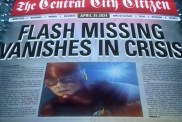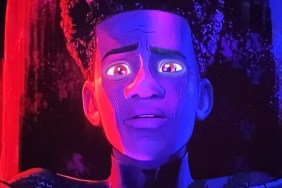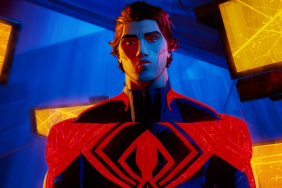On the 4K Blu-ray commentary track for Spider-Man: Across the Spider-Verse, which features directors Joaquim Dos Santos, Kemp Powers, and Justin K. Thompson with writer-producers Chris Miller and Phil Lord, they describe the way they wanted characters to pop out from the background in Gwen Stacy’s universe. Deciding they didn’t want them to stand out too much, but to fit in with the watercolor aesthetic, the team was nonetheless told to make sure it still looked expensive. In that moment, and every other, they succeeded.
Between the Lines
You should reward their efforts by purchasing the most expensive presentation of the movie available, namely the 4K disc, as it puts even the digital version to shame. The digital copy as screened on Movies Anywhere looked dulled down, while the 4K is vibrant, with every line detail and subtle faux wireframe marker visible. All the comic-style linework, all the tiny circuitry details in the future tech, filled in with the brightest colors, really pop on the UHD disc. And on a home TV screen — even a really big one — the short-attention-span editing is easier to process than on the big screen. For those of us over 25, anyway.

Note: The 4K version is the same as the digital version with regard to changes made since the theatrical. I’m generally not in favor of that — they don’t really affect this overall movie that much, but the principle of the movie seen in theaters being the same one you get at home is one that cinephiles should stand behind, or you get messes like the Star Wars Special Editions or the home cut of Battlefield Earth that trims John Travolta’s most ridiculous bits of overacting that were the only reason to see it. Extended or revised cuts labeled as such are fine, but keep the theatrical release available always.
Revisit, Reward
My initial reaction to Across the Spider-Verse, like its predecessor, was tentative, allowing for the fact that I’d probably grow to like it more later, as I had the first. And so it has happened. Once one no longer has to focus on the actual plot of these movies and can linger in the intricacies of the worlds they create, they’re more enjoyable. The commentary enhances things even further, with lots of discussion about the various choices made, how the backgrounds reflect the scene’s theme, and so on.

To cite but one example, the scene in which Peter B. Parker (Jake Johnson) tries to talk down Miles Morales (Shameik Moore) in the industrial bowels of a utopian future city, is broken down thusly: they’re in the engine of the city while talking about the engine of the plot, and the gears and pistons act like Miles trying to close doors to Peter while Peter keeps opening and walking through them. There’s more to it than that, but the way they break down scenes with sets and action reflecting internal themes helps open the film up to deeper reads. The commentary track isn’t available on the Vudu or Movies Anywhere versions, but it is on the 4K disc itself rather than just the Blu-ray copy, which more studios should do. Alas, the commentary does not address the changes made since the theatrical cut. As far as these extras are concerned, that didn’t happen.
Turn off the Dark?
My wife observed, with some disappointment, that this sequel had fewer laughs than the first. It’s probably evident to fans that this is the dark, cliffhanger-y Empire Strikes Back of the trilogy, but if you’re pitching it to casual viewers who just really liked the talking pig in part one, take note. Not that it’s unamusing — Spider-Punk (Daniel Kaluuya), Ben Reilly (Andy Samberg), and Pavitr Prabhakar (Karan Soni) are plenty amusing, as is arch-villain The Spot (Jason Schwartzman). For the movie to end on a cliffhanger, though, those humorous elements must take a backseat at the very end, and that comedic bad guy has to become a seriously real threat rather than an amazingly thought-out sight gag (not that there’s anything wrong with that!). It’s hard to rate movies that feel like half a movie, but on rewatch, Across the Spider-verse not only holds up, but fares even better as its own thing.

There are plenty of bonus featurettes included, most of which stick to technical and design aspects and also suggest that producers Amy Pascal and Avi Arad should really study that Steve Buscemi “How do you do, fellow kids?” meme next time they dress and style themselves. Many of the actual comic book artists who served as inspiration also got to work on the movie and appear on camera, and diversity is highlighted particularly for the India sequences, for which the filmmakers assembled a whole team of Indian consultants to make things more culturally authentic and redesign Pavitr and Mumbattan from the ground up (or more literally, from the skyline down). Two music videos, for the songs “Annihilate” and “Calling,” mostly feature film footage with lyrics over-written but nicely foreground the tunes. An Easter Egg compilation points out what many of the graffiti tags and numbers onscreen mean and call out cameos by filmmakers as animated extras. A deleted scene that originally featured Miles meeting Miguel much earlier gives some of the supporting spiders more lines, but was best omitted.
Spider-Colors
For all the diversity talk, it seems clear that racism was a forbidden topic to discuss on these bonus features, even thematically. The closest anyone comes is on the commentary track, when it’s mentioned that Jessica Drew (Issa Rae) is of a generation that “had to make compromises” or that Miles’ dad’s original name of Jefferson Davis was problematic. Miles is literally told he’ll be discriminated against by elite institutions, and it actually happens; plus one of his powers is to actually disappear, and the Ralph Ellison Invisible Man comparisons write themselves. Not to mention the way the “canon events” theme reflects ties we so often see online between angry fans insistent on strict fealty and casual bigotry.
One possibility is that Sony doesn’t want to alienate any fans at all or get certain crowds all worked up about “woke.” It should be interesting indeed to see if Miles and Gwen (Hailee Steinfeld) get to be more than just friends in part three or if the movie will pull a Rey-Finn maneuver in fear of Chinese boycotts and stay in the ‘zone. Fortunately, the movie as it stands now speaks pretty clearly for itself, even if it doesn’t use specific words to do so.
Across the Spider-Verse probably doesn’t need yet another recommendation, but it gets it anyway. The 4K presentation is one that will work quite nicely as a show-off disc to demonstrate what your UHD TV can do, and the commentary is required listening for aspiring filmmakers or anyone interested in filmmaking. There’s plenty else touting all the design and tech, and the music videos make a good cherry on top.
And Yet…
So why doesn’t it get a perfect score? Only because of the principle of the theatrical cut not being honored. Filmmakers, don’t do this. Or at the very least, if you do, include the alternate takes somewhere on the disc.
Grade: 4.5/5
Spider-Man: Across the Spider-Verse is now available on Blu-ray, 4K, and DVD.









